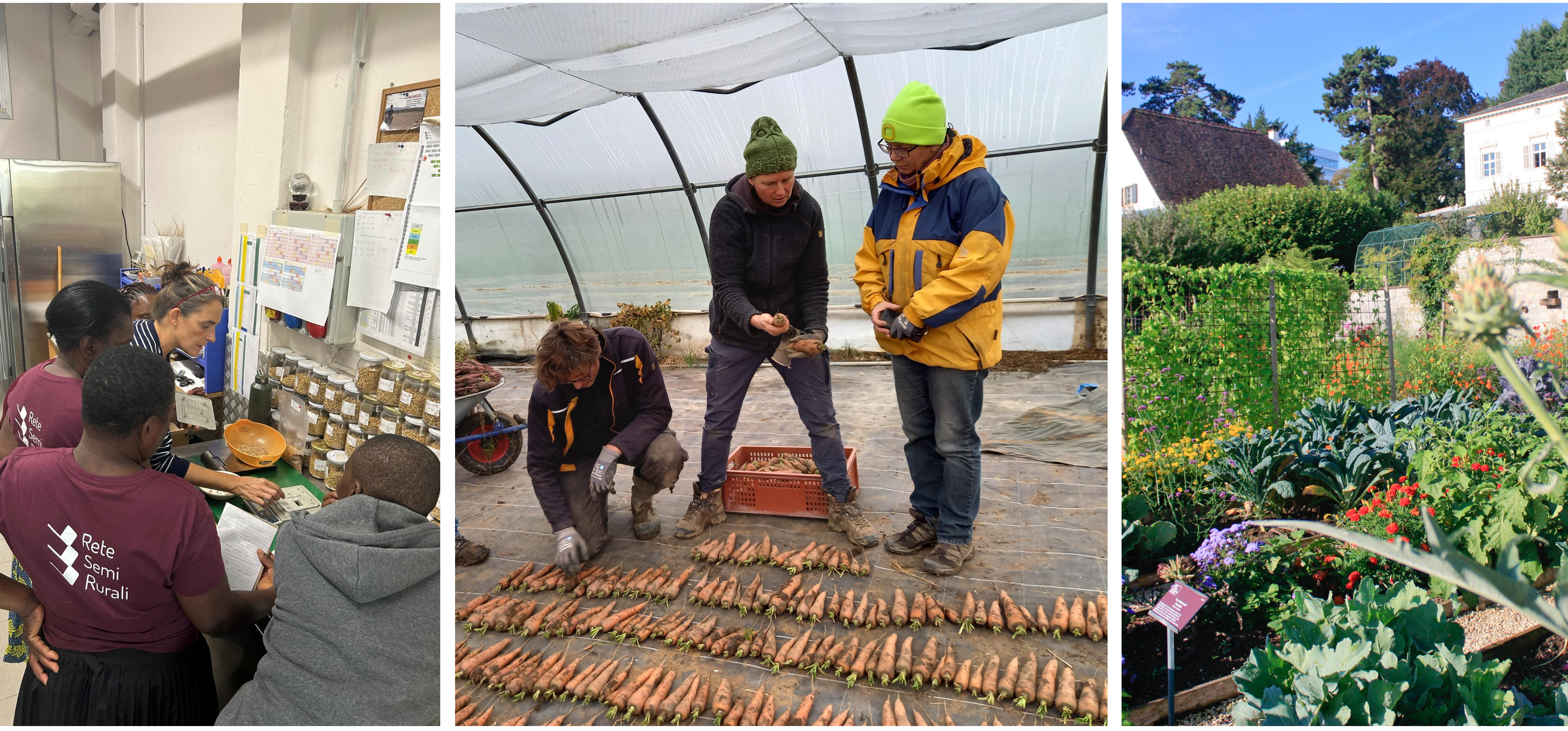Community seedbanks in Europe: their role between ex situ and on-farm conservation
Main Article Content
Abstract
This article enlightens the role of community seedbanks (CSBs) in Europe within the plant genetic resources for food and agriculture community and their role in the conservation and sustainable use of agrobiodiversity in complementarity with the ex situ management system. For more than 40 years, CSBs around the world have emerged as part of the so-called informal seed system to counteract the loss of locally adapted varieties through the development of collective seed systems. Most of the studies and articles refer to experiences from the Global South, whereas a comprehensive analysis of the impact and role of CSBs on seed systems in industrialized countries is still missing. This paper provides three case studies describing the community seed banking experience of different European organizations: Pro Specie Rara (Switzerland), Arche Noah (Austria) and Rete Semi Rurali (Italy). These organizations exemplify the diversity among European CSBs and their efforts to engage with genebanks and the formal seed system.
Article Details

This work is licensed under a Creative Commons Attribution 4.0 International License.
Authors retain copyright of the articles published in Genetic Resources and grant the journal right of first publication with open access. All articles published in Genetic Resource are licensed under Creative Commons Attribution 4.0 International License (CC BY 4.0) that allows others to download, share and adapt the work for commercial and non-commercial purposes as long as proper attribution to the original article is given. Genetic Resources permits and encourages authors to post items submitted to the journal (including the publisher's final layout) on personal websites or institutional repositories after acceptance and/or publication, while providing bibliographic details that credit their publication in Genetic Resources.
Bartha, B et al. (2021). Community seedbank management guidelines along four network showcases. Farmer’s Pride: Networking, partnerships and tools to enhance in situ conservation of European plant genetic resources. URL: https://more.bham.ac.uk/farmerspride/wp-content/uploads/sites/19/2021/07/D2.3_Community_seedbank_management_guidelines.pdf.
Bocci, R, B Bussi, et al. (2020). “Yield, yield stability and farmers’ preferences of evolutionary populations of bread wheat: A dynamic solution to climate change”. European Journal of Agronomy 11(121), p. 126156. DOI: https://doi.org/10.1016/j.eja.2020.126156. DOI: https://doi.org/10.1016/j.eja.2020.126156
Bocci, R and G Galluzzi (2015). “Guida ai Sistemi Sementieri”. Rete Semi Rurali. URL: https://rsr.bio/wp-content/uploads/2021/02/Guida-ai-sistemi-sementieri.pdf.
Ceccarelli, S and S Grando (2020b). “Review. Evolutionary Plant Breeding as a Response to the Complexity of Climate Change”. iScience 23, p. 101815. DOI: https://doi.org/10.1016/j.isci.2020.101815. DOI: https://doi.org/10.1016/j.isci.2020.101815
De Santis, G et al. (2022). “Participatory Evaluation of Rice Varieties for Specific Adaptation to Organic Conditions in Italy”. Sustainability 14, p. 10604. DOI: https://doi.org/10.3390/su141710604. DOI: https://doi.org/10.3390/su141710604
DeBoeuf, W S et al. (2013). Community Biodiversity Management. Promoting resilience and the conservation of plant genetic resources. Issues in Agricultural Biodiversity. Bioversity International, Routledge, p. 456. DOI: https://doi.org/10.4324/9780203130599. DOI: https://doi.org/10.4324/9780203130599
Didonna, A et al. (2024). “The Conservation Varieties Regime: Its Past, Present and Future in the Protection and Commercialisation of Vegetable Landraces in Europe”. Horticulturae 10, p. 877. DOI: https://doi.org/10.3390/horticulturae10080877. DOI: https://doi.org/10.3390/horticulturae10080877
EU (2008). 2008/62/EU: Commission Directive of 20 June 2008 providing for certain derogations for acceptance of agricultural landraces and varieties which are naturally adapted to the local and regional conditions and threatened by genetic erosion and for marketing of seed and seed potatoes of those landraces and varieties. URL: http://data.europa.eu/eli/dir/2008/62/oj.
EU (2009). 2009/145/EU: Commission Directive of 26 November 2009 providing for certain derogations, for acceptance of vegetable landraces and varieties which have been traditionally grown in particular localities and regions and are threatened by genetic erosion and of vegetable varieties with no intrinsic value for commercial crop production but developed for growing under particular conditions and for marketing of seed of those landraces and varieties. URL: http://data.europa.eu/eli/dir/2009/145/oj.
EU (2010). 2010/60/EU: Commission Directive of 30 August 2010 providing for certain derogations for marketing of fodder plant seed mixtures intended for use in the preservation of the natural environment. URL: http://data.europa.eu/eli/dir/2010/60/oj.
EU (2014). 2014/150/EU: Commission Implementing Decision of 18 March 2014 on the organization of a temporary experiment providing for certain derogations for the marketing of populations of the plant species wheat, barley, oats and maize pursuant to Council Directive 66/402/EEC (notified under document C(2014) 1681). URL: http://data.europa.eu/eli/dec_impl/2014/150/oj.
EU (2018). Regulation (EU) 2018/848 of the European Parliament and of the Council of 30 May 2018 on organic production and labelling of organic products and repealing Council Regulation (EC) No 834/2007. URL: http://data.europa.eu/eli/reg/2018/848/oj.
Galluzzi, G, M Lorimer, and R Bocci (2021a). Community Seed Banks - Access to germplasm and benefit sharing models. URL: https://liberatediversity.org/wp-content/uploads/2021/05/Manual3_ENG_single_pages-3-1.pdf.
Galluzzi, G, M Lorimer, and R Bocci (2021b). Community Seed Banks - Documentation systems: a tool for data and information management. URL: https://liberatediversity.org/wp-content/uploads/2021/05/Manual2_web_single_pages-6.pdf.
Galluzzi, G, M Lorimer, and R Bocci (2021c). Community Seed Banks - Establishment, Management and Governance. URL: https://liberatediversity.org/wp-content/uploads/2021/05/Manual1_web_single_pages-4.pdf.
Heistinger, A (2013). The Manual of Seed Saving: Harvesting, Storing, and Sowing Techniques for Vegetables, Herbs, and Fruits. Timberpress.
IPES-Food (2016). From uniformity to diversity: a paradigm shift from industrial agriculture to diversified agroecological systems. International Panel of Experts on Sustainable Food systems.
Koller, B and R Bocci (2018). Community biodiversity management. An analysis of Community Seed Banks in Europe. URL: https://www.diversifood.eu.
Petitti, M et al. (2022). “Evolutionary Participatory Selection for Organic Heterogeneous Material: A Case Study with Ox-Heart Tomato in Italy”. MDPI-Sustainability 14, pp. 11030–11030. DOI: https://doi.org/10.3390/su141711030. DOI: https://doi.org/10.3390/su141711030
RIS (2025). Verordnung des Bundesministers für Land- und Forstwirtschaft, Umwelt und Wasserwirtschaft, mit der Durchführungsbestimmungen zum Saatgutgesetz 1997 erlassen werden (Saatgutverordnung 2006). StF: BGBl. II Nr. 417/2006. URL: https://faolex.fao.org/docs/pdf/aut72640.pdf.
Vernooy, R, P Shrestha, and B Sthapit (2015). Community Seed Banks, Origins, evolution and prospects. Issues in Agricultural Biodiversity. Bioversity International, Routledge, p. 270. DOI: https://doi.org/10.4324/9781315886329. DOI: https://doi.org/10.4324/9781315886329







 This journal has been conceived as part of the
This journal has been conceived as part of the